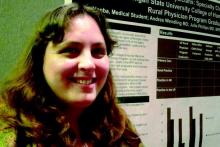NEW YORK – Graduates of a clinical program designed to train family practice physicians in a rural setting were significantly more likely to practice in rural areas than their peers who trained in a medical school located in more populous areas, according to a poster presented at this year’s North American Primary Care Research Group annual meeting.
Over a ten-year period, nearly half of all graduates of the Michigan State University College of Human Medicine’s Rural Physician Program, a clinical track specifically designed to expose students to life and practice in a rural setting, chose to practice in a rural setting, nearly four times more than graduates of the university’s main campus medical school.
“When the program started, there was a lot of skepticism as to whether it would be successful,” Dr. Julie Phillips, a family physician and assistant dean for student career development at the University’s East Lansing campus, said in an interview. An author of the retrospective analysis, Dr. Phillips said the program enrolls an average of 12 students annually, a quarter of whom stay in the region to set up practice.
The program was created in 1974 to address a shortage of family physicians in Michigan’s Upper Peninsula, and enrolls students who express an interest in rural practice. Once a student’s clinical training is complete, including a residency that typically occurs in Marquette, the Upper Peninsula’s most populous city with just under 22,000 residents, but a retrospective cohort analysis showed that 42.2 percent of participants enrolled from 1996 to 2006 chose to either return or stay in a more rural setting to set up their practice.
“It looks like [the program] has been a success,” Dr. Phillips said.
She also said relative to other medical schools, the program graduates tended to remain in the state and set up family care practices post-graduation, but that the rural residency program was “significantly better” at attracting physicians than the college’s traditional medical school program. She did not know what proportion of the program graduates who chose rural settings had actually grown up in the areas where they practiced, but said it was a predictor she and her colleagues were considering in a secondary analysis.
“Historically, we have attracted students who did grow up in the Upper Peninsula, but many students who become interested in rural practice actually don’t grow up in rural communities,” Dr. Phillips said.
During the time period studied, 55 percent of rural training track graduates chose to set up a primary care practice, roughly 15 percent more than the ratio of students graduated by the college’s main medical facility (P = .015). More than half of rural track graduates also chose to practice in Michigan, compared with 40 percent of the medical school graduates from the main campus (P = .006). A quarter of the rural program’s graduates stayed to practice in the Upper Peninsula, compared with the one percent of physicians graduated from the main campus (P less than .001) who chose to settle in the Upper Peninsula. Overall, 42.2 percent of rural program graduates set up practice in any rural area during the time period studied, compared with 13 percent of graduates from the main medical school (P less than .001)
Dr. Phillips and her colleagues considered a community rural if it met Code 4 specifications from the U.S. Department of Agriculture’s Rural Continuum – typically populations of 20,000 or less. The results of the program are impressive, Dr. Dana E. King, professor and chair of family medicine at the University of West Virginia, said in an interview.
Being able to attract people to places that are somehow geographically undesirable, either because they are isolated, have harsh winters, or aren’t near a city, is difficult.” The key to success is appealing to the physician’s spouse, said Dr. King. “What if you’re married to a Ph.D. in something, or another physician? There is a challenge to provide enough opportunities for both the physician and spouse. The fact that [Michigan State University’s rural practice program] has had these kind of results is a testament to the fact that it pays attention to the needs of the physician’s family and to the entire community.”
Dr. King, who is the secretary and treasurer of the North American Primary Care Research Group, is not affiliated with the study.
Dr. Phillips said that the program curriculum does address the specific challenges -- and rewards -- of living and practicing in a rural community, but that the program’s rural location itself was the most instructive. “The students are already there. They’re in medical school in a rural setting. They don’t need to go somewhere else to learn about a rural life after they learn medicine.”


